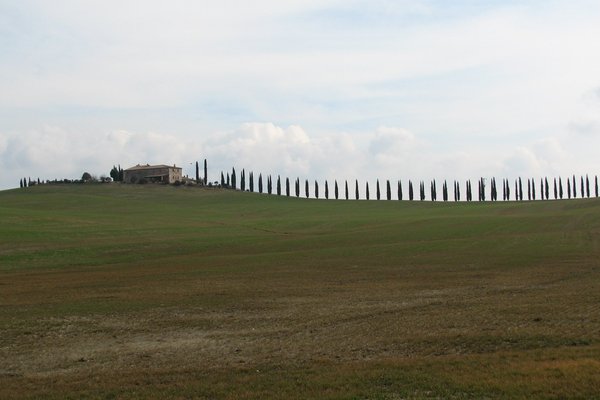Italy
Val d'Orcia
The Val d'Orcia is a cultural landscape from the Renaissance comprising an aesthetically pleasing combination of farmlands and fortified villages on hilltops.
The landscape as it unfolds nowadays was created as an investment by wealthy Siennese merchants in the 14th and 15th centuries. The farmers cultivated mainly grains, vines and olives, and had to share part of their revenue with the merchants as rent. The beauty of the area inspired Renaissance painters and early travellers on the Grand Tour alike.
Community Perspective: It’s quintessentially Tuscan, with hills, olive trees and rows of cypresses. It’s best to just drive around and take it all in. A few reviewers have named highlights such as Bagno Vignoni (Tsunami), the Cipressi di San Quirico d'Orcia (Frederik), and the Romanesque Abbey of S Antimo (Matejicek).
Site Info
Official Information
- Full Name
- Val d'Orcia (ID: 1026)
- Country
- Italy
- Status
-
Inscribed 2004
Site history
History of Val d'Orcia
- 2004: Inscribed
- Inscribed
- Type
- Cultural
- Criteria
- iv
- vi
Links
- UNESCO
- whc.unesco.org
- Official
-
- parcodellavaldorcia.com — Parco della Val d'Orcia
- Related
-
- en.wikipedia.org — Also part of the inscribed area: St. Antimo's Abbey
- valdorcia-info.com — Info on several sites in the Val d'Orcia
All Links
UNESCO.org
- whc.unesco.org — whc.unesco.org/
Official Website
- parcodellavaldorcia.com — Parco della Val d'Orcia
Related Resources
- en.wikipedia.org — Also part of the inscribed area: St. Antimo's Abbey
- valdorcia-info.com — Info on several sites in the Val d'Orcia
Community Information
- Community Category
- Cultural Landscape: Associative
Travel Information
Recent Connections
-
Rose garden
Rose garden in San Quirico d'Orcia (Wik…
-
Exact locations inscribed twice (or more)
Includes Pienza
-
Chalk
The landscape's distinctive aesthetics,…
Connections of Val d'Orcia
- Individual People
-
-
Frederick Barbarossa
In the San Quirico countryside in 1155 the meeting between the papal representatives and Frederick I took place to discuss the terms of the latter's coronation.See it.wikipedia.org
-
Charlemagne
According to tradition, Sant'Antimo Abbey was founded in 781 by Charlemagne in response to a grace received: the emperor and his troops had been spared from the plague that was raging in the region, during his return journey from Rome, where he received from the Pope the bodies of Saints Antimo and Sebastian. (Nomination file, p. 86) The foundation by Charlemagne is almost certainly to be interpreted as a pure medieval legendSee it.wikipedia.org
-
Simone Martini
The Romanesque church of Santi Stefano and Degna in Castiglione d'Orcia houses a 'Madonna with Child' by Simone Martini.See en.wikipedia.org
-
- Geography
-
-
Hot Springs
Bagni San Filippo is a small hot spring with waters of up to 50°C. (Nomination file, p. 74)See en.wikipedia.org
-
Contiguous National Sites
With Pienza
-
- Trivia
-
-
Tourist Treks
Via Francigena (Pilgrims Route to Rome) -
Built or owned by French
In 1118, construction of the new church of Sant'Antimo Abbey began, under the guidance of Abbot Guidone. The most important point of reference for the project of the new church was the great Benedictine abbey of Cluny. The abbot requested the intervention of French architects to design the new building, which was partly inspired by the Benedictine church of Vignory from 1050.See it.wikipedia.org
-
- History
-
-
Popes
"Both Pope Pius II and his nephew Pope Pius III were baptized at the baptismal font" of the Pieve di CorsignanoSee en.wikipedia.org
-
Via Francigena
Via Francigena and its associated abbeys, inns, shrines, bridges etc are explicitly included in this WHS -
Carolingian Empire
According to tradition, Sant'Antimo Abbey was founded in 871 by Charlemagne. (Nomination file, p. 86) On 29 December 814, a document by Louis the Pious, son and successor of Charles, enriched the abbey with gifts and privileges. The abbey became, in all respects, an imperial abbey.See it.wikipedia.org
-
Etruscans
(...) a series of excavation campaigns has brought to light on the Poggio Civitella, near Montalcino, the remains of an imposing Etruscan fortress which is one of the first buildings of this type identified and the only one unearthed so far. (Nomination file, p. 52)See it.wikipedia.org
-
Medici
After the fall of Montalcino under the control of the Medici, the latter had the bastion of San Giovanni expanded and the tower of the Palazzo dei Priori raised, making them reach their current dimensions. In addition, the Medici, to obviously leave a mark of their dominion over the city, added the Medici coat of arms to many palaces and defensive works; an example is the Palazzo dei Priori.See it.wikipedia.org
-
Neolithic age
The archaeological area of Cava Barbieri: The oldest settlement dates back to the early Neolithic. Later remains are indicative of contacts with other groups from central and northern Italy, with Linear ceramics, and the "Ripoli culture"; then in the last phase of the Neolithic with groups from southern Italy and Sicily with the Diana culture. (Nomination file, p. 111) -
Sieges and Battles
In 1199 Siena laid siege to Montalcino, which lasted 16 months, ending with the Sienese victory and the destruction of a good part of the castle. There was another siege in 1201-1202, that ended in the destruction of Montalcino. More sieges occurred in 1207, 1219, 1232 and 1252, when Montalcino rebelled against Siena.See it.wikipedia.org
-
- Ecology
-
-
Notable Trees
"Cypresses form a striking addition to the landscape planted along routes and around settlements, their regular form punctuating the rounded shapes of the hills and their dark colour contrasting strikingly with the pale landscape." (AB Ev) - More than any other tree, the cypress symbolizes the Val d'Orcia. Whether isolated, in the scrubland or planted in rows, it became a constituent element of the new landscape from the Renaissance onwards, as evidenced by all the iconography of the time, which exalts its symbolic and figurative values. (Nomination file, p. 51)See it.wikipedia.org
-
Chalk
The landscape's distinctive aesthetics, flat chalk plains out of which rise almost conical hills with fortified settlements on top (OUV statement)
-
- Architecture
-
-
Renaissance
"Val d'Orcia, in the Province of Sienna, Tuscany (central Italy), is a rural agricultural landscape that retains much of its Renaissance layout, character and aesthetic." – "The Val d'Orcia is an exceptional reflection of the way the landscape was re-written in Renaissance times to reflect the ideals of good governance and to create an aesthetically pleasing picture." (OUV) -
Gothic
Several buildings have Gothic elements, e.g. in Montalcino, the Gothic arcades of the loggia of the Palazzo dei Priori, the Gothic portal of the church of S. Agostino and Gothic elements in the church of Sant'Egidio. In Monticchiello, the Gothic portal of the church of S. Leonardo and Cristoforo. (Nomination file, p. 79, 84, 104)See en.wikipedia.org
-
Romanesque
Sant'Antimo abbey -
Italian Renaissance garden
Horti Leonini in San Quirico d'Orcia (Nomination file, p. 113) -
Spolia
Montalcino Cathedral: "The bell tower dates from the eighteenth century. The materials for its construction were taken from the Romanesque church of San Pietro in Asso."See en.wikipedia.org
-
Rose garden
Rose garden in San Quirico d'Orcia (Wikipedia)
-
Brick architecture
The rural houses - case poderali – (...). Built in brick, traditionally located in a dominant position allowing to control the surrounding fields, they generally have large arcades and the traditional dovecotes on the outside. (Nomination file, p. 50) -
Rock Cut Architecture
The cave of San Filippo Benizi is a small oratory located in Bagni San Filippo in Castiglione d'Orcia, carved out of a large block of travertine in the shape of a vault closed at the ends by two walls and divided in two by a partition wall. (Nomination file, p. 74-75)See it.wikipedia.org
-
Pre-Romanesque
"The foundation of the original Benedictine monastery" of Sant'Antimo "dates to the time of Charlemagne. (...) Parts of the earlier structure remain visible in the crypt and in the so-called Cappella Carolingia, or Carolingian chapel. (...) Of the Carolingian edifice, the apse (called Cappella Carolingia) and the portal, richly decorated with animal and vegetable motifs, are visible."See en.wikipedia.org
-
Baroque
Palazzo Chigi Zondadari in San Quirico d'OrciaSee it.wikipedia.org
-
Neoclassical architecture
The San Salvator Cathedral of Montalcino was completely rebuilt between 1818 and 1832, in the neoclassical style by the architect Agostino Fantastici. (Nomination file, p. 79)See en.wikipedia.org
-
- Damaged
-
-
Damaged in World War II
In San Quirico d'Orcia, the Allied bombings caused the destruction of two historic towers, one located in the center of the Horti Leonini and the other at the entrance to the town.See it.wikipedia.org
-
- World Heritage Process
-
-
2 or more nominated criteria rejected by AB
Rejected: 2, 3. Accepted: 4, 6. -
Recommended for combination by AB
"Pienza a key part of the Val d'Orcia is already a WHS and will become surrounded by the Val d'Orcia if it is inscribed. Consideration should be given to combining the 2 sites" (ICOMOS) -
Exact locations inscribed twice (or more)
Includes Pienza
-
Perfect Inscriptions
2004
-
- Religion and Belief
-
-
Franciscan Order
The church of S. Francesco in Montalcino was given to the Franciscans friars in 1285. (Nomination file, p. 85) -
Augustinian Order
The former Augustinian convent and the church of S. Agostino in Montalcino. The convent now houses the civic museum. (Nomination file, p. 79, 84, 85)See en.wikipedia.org
-
Pilgrimage route
Via Francigena (Nomination file, p. 57-58)See en.wikipedia.org
-
Premonstratensians
Premonstratensians inhabited Sant'Antimo Abbey from 1992 until 2015, when they decided to leave the abbey to move to that of Saint-Michel de Frigolet, near Avignon, due to the decline in vocations in France and the impossibility of growing the community in the spaces of Sant'Antimo.See it.wikipedia.org
-
Benedictines
Sant'Antimo Abbey was originally a Benedictine monastery. (Nomination file, p. 86)See it.wikipedia.org
-
Cathedrals
Montalcino Cathedral (Nomination file, p. 79)See en.wikipedia.org
-
Female Christian Mystics
In the year 1377, the stay at the Rocca di Tentennano of Saint Catherine of Siena is documented. She came here to reconcile the two branches of the Salimbeni family who were fighting each other relentlessly in a fratricidal struggle. The Saint remained a guest at the Rocca where, according to legend, she miraculously received the gift of writing: upon awakening from a sleep, she took the pen in her hand and began to work on the Dialogo della Beata Provvidenza, one of her most important compositions.See it.wikipedia.org
-
Saint Vitus
"The Pieve di Corsignano is a (...) rural parish church (...) within the town limits of Pienza, (...) dedicated in the honor of Saints Vito and Modesto."See en.wikipedia.org
-
Saints' Caves
The cave of San Filippo Benizi is a small oratory located in Bagni San Filippo in Castiglione d'Orcia, carved out of a large block of travertine. The saint withdrew here in 1269, on the occasion of the conclave of Viterbo, to avoid being elected as successor to Clement IV. (Nomination file, p. 75)See it.wikipedia.org
-
Servite Order
The cave of San Filippo was originally a hermitage that belonged to the Servants of Mary. After its abandonment, the order took possession of it again. (Nomination file, p. 75)See it.wikipedia.org
-
- Human Activity
-
-
Festivals
Monticchiello is known for its so-called "poor" theater (teatro povero) in which all the inhabitants are authors/actors that takes place in the summer, outdoors every year for over 50 years. (Nomination file, p. 104) - The Barbarossa festival is celebrated on the third Sunday of June in San Quirico d'Orcia. The festival recalls the meeting in 1155, between Frederick of Swabia called Barbarossa and the papal envoys to discuss the imperial coronation by the Pope in Rome.See it.wikipedia.org
-
Grand Tour
"The agricultural landscape, which was inspired by and influenced Siennese painters of the Renaissance, has continued to incite – for example, travellers of the European 'Grand Tour' and modern-day photographers." (OUV) -
Transhumance
"Farmers practiced transhumance with routes to Meremma and l'Amiata." (AB Ev) -
Mints
During the Republic of Siena, which took refuge in Montalcino, the lower part of the Palazzo dei Priori was transformed into the headquarters of the State Mint of the Republic.See it.wikipedia.org
-
Pastoralism
an agrarian and pastoral landscape reflecting innovative land-management systems (AB ev) -
Textiles
The existence of fulling mills at Bagno Vignoni is documented from 1416. (Nomination file, p. 123) -
Salt
The lower part of the Palazzo dei Priori in Montalcino was originally used as a salt warehouse.See it.wikipedia.org
-
Olive Tree Landscapes
"The area comprises small-scale, mixed-produce farms on which grain, vines, olives, fruit, and vegetables are cultivated." (OUV) -
Vineyards
"The farms were mixed farms cultivating grain, vines, olives, fruit and vegetables and with hay meadows and pastures interspersed between the farms for livestock. (...) An illustration of the aim for the farming landscape to create pleasing pictures is the persistent tradition of planting roses to embellish vineyards." (AB Ev) -
Frescoes or murals by famous painters
The frescoes in the refectory of Sant'Anna in Camprena are by Il Sodoma (1502-1503). (Nomination file, p. 106) On the back wall of the church of San Michele in Montalcino you can see a fresco divided into three scenes by Pietro Lorenzetti, his last certain work. The frescoes, of great scope, discovered around 1876, were executed in 1345, as reported by the inscription under the central panel of the Annunciation.See it.wikipedia.org
-
- Constructions
-
-
Baths
The spa towns of Bagni San Filippo and Bagno Vignoni (Nomination file, p. 74, 122) -
Monumental Fountains
Fonti Castellane and Fonte degli Appicciati in MontalcinoSee it.wikipedia.org
-
Pyramids
The Bosco Isabella is a self-described "romantic and esoteric garden" that combines a partly natural and cultivated arboretum along with a monumental triangular stone step pyramid.See en.wikipedia.org
-
Clock Tower
The clock tower of the Palazzo dei Priori in Montalcino. -
Granaries
In the nineteenth century, the rectangular building at Cosona Castle was built and used as a granary.See it.wikipedia.org
-
Hospitals
Hospitals along the Via Francigena, e.g. hospitals of Le Briccole and Arcimboldo. The former Hospitals of S. Maria della Croce in Montalcino and Santa Maria della Scala in San Quirico d'Orcia. (Nomination file, p. 63, 71-72, 85, 120)See it.wikipedia.org
-
Cemeteries
Several cemeteries are included in the Val d'Orcia WHS, e.g. the cemetery of the monastery of Sant'Anna in Camprena.See it.wikipedia.org
-
Unfinished constructions
The costs of rebuilding the church and the convent of Sant'Antimo Abbey exceeded the economic possibilities of the Benedictine monks; and the façade and part of the service premises of the convent were not completed. (Nomination file, p. 86, 89) -
Walled cities
Monticchiello almost entirely preserves its walls which enclose the entire urban center and takes position on the fortress placed on the top of the hill. (Nomination file, p. 103-104) -
Necropolises
Pianoia necropolis (Nomination file, p. 111) -
Theatres and Opera Houses
Teatro degli Astrusi in MontalcinoSee it.wikipedia.org
-
Loggia
AB evaluation "The statement of significance draws attention to the way the large farmhouses assume a dominant position in the landscape and are enriched by prominent architectural elements such as loggias, belvederes, porches and avenues of trees bordering the approach roads" -
Dovecotes
The rural houses - case poderali – (...). Built in brick, traditionally located in a dominant position allowing to control the surrounding fields, they generally have large arcades and the traditional dovecotes on the outside. (Nomination file, p. 50)
-
- WHS on Other Lists
-
-
Most beautiful villages
Radicofani and Pienza are among the Bandiere arancioni ('orange flags') by the Touring Club Italiano -
ViTour
-
- Timeline
-
-
Built in the 14th century
Landscape was made in the 14th century (AB)
-
- WHS Hotspots
- WHS Names
-
-
Named after a River
"derives from the river Orcia, which runs through the valley and flows for about 70 kilometers "
-
- Literature & Film
-
-
Location for a classic movie
"NOSTALGHIA" (TARKOVSKY/1982) AT BAGNO VIGNONI. Best Director & FIPRESCI Award at Cannes.
-
News
No news.
Recent Visitors
Visitors of Val d'Orcia
- Afshin Iranpour
- Aitia
- Albert
- Alberto Rodriguez Gutierrez
- Alexander Barabanov
- Alexander Lehmann
- Alex Goh
- Alvaro1404
- A. Mehmet Haksever
- Ammon Watkins
- Andrea Szabo
- Argo
- Aspasia
- Astraftis
- Atila Ege
- AustralLights
- AYB
- Badwater
- BaziFettehenne
- Bill Maurmann
- Bin
- Bodil Ankerly
- Bropyk
- butterflybird
- Cezar Grozavu
- chenboada
- chenqtao
- Cheryl
- ChrisN
- Christravelblog
- Claire Bradshaw
- Cluckily
- Clyde
- Cobaltrage
- Cristina Erba
- Csaba Nováczky
- Cyberczar
- Daniela Hohmann
- Daniel Gabi
- Dan Pettigrew
- David Aaronson
- David Berlanda
- David Marton
- DavidS
- Dimitar Krastev
- Dimitrios Polychronopoulos
- DL
- Dorejd
- Dr. Caligari
- Elia Vettorato
- eljx1988
- Els Slots
- Erik Jelinek
- Errol Neo
- Evgenii
- fabi-ddorf
- Fan Yibo
- Farinelli
- Federico P.
- Flexiear
- Frédéric M
- Frederik Dawson
- George Gdanski
- GeorgeIng61
- GerhardM
- Gernot
- giulio25
- grimloch
- Hadrianus
- HaraldOest
- Harry Mitsidis
- Hasco
- hdimoshi
- Hubert
- Iain Jackson
- Ilya Burlak
- Ivan Rucek
- Jaakkotoivanen
- Jakob F.
- James Bowyer
- Janina Lehmann
- Jarek Pokrzywnicki
- Jarrod_Byham
- Jeanne OGrady
- Jens
- jess4sythe
- Jesse S 2010
- Jezza
- Joel on the Road
- Jonas Hagung
- Jonas Kremer
- Jon Eshuijs
- Jurre
- Karito Vies
- Ken DJ
- Knut
- Krzysztof B
- Kurt Lauer
- La Concy
- Lara Adler
- LaVale
- Linz
- Lisu Marian
- Loic Pedras
- Luboang
- Luis Filipe Gaspar
- Maciej Gil
- Maciej Gowin
- Malgorzata Kopczynska
- Małgosia Łupicka
- marcel staron
- MarcoB_0
- Marinemajor
- Martina Rúčková
- Matejicek
- Mateusz
- Mathijs
- MAURO PODDA PANI
- MaYumin
- MichaelH
- Michael Turtle
- Mikko
- MMM
- Mo-han Je
- Monica Tasciotti
- Mtlmr
- Naim Y
- nan
- Nasebaer
- Nihal Ege
- NoahFranc
- opperpco3
- PabloNorte
- palka25
- Patrik
- Paul Schofield
- PeterH
- Peter Lööv
- Petteri
- Philipp Leu
- Philipp Peterer
- phillipmeng
- Piotr Wasil
- Rafał Kałczuga
- Ralf Regele
- Randi Thomsen
- reddargon
- Reiseblog
- Remigiusz
- Riccardo Quaranta
- rivr
- Roccobot
- Roel Sterken
- Roger Ourset
- Roman Bruehwiler
- Rudegirl
- Sabrina Liebehentschel
- Samy G
- Schnitzel
- Sebasfhb
- Sergio Arjona
- Shandos Cleaver
- sime147
- SirLoydd
- Slavi
- Solivagant
- Squiffy
- Stanislaw Warwas
- StaziG
- stephanvermeulen
- Stijn
- Svein Elias
- Szabolcs Mosonyi
- Szabo Viktoria
- Szucs Tamas
- Tamara Ratz
- Taotao Chen
- Tarquinio_Superbo
- Thomas Buechler
- Thomas van der Walt
- Tim Allen
- Tom Flaten
- Tonisan
- tony0001
- Traveling Girl
- triath
- Truls Brekke
- Tsunami
- Twobaconsandaboston
- Valentina
- ValiaVeweth
- Vanessa Buechler
- Viaje al Patrimonio
- Vincent Cheung
- Walter
- Westwards
- Wieland
- WILLIAM RICH
- Wimmy
- Wojciech Fedoruk
- Wo_ko
- Xiong Wei
- Xiquinho Silva
- Yevhen Ivanovych
- Zoë Sheng
Community Reviews
Show full reviews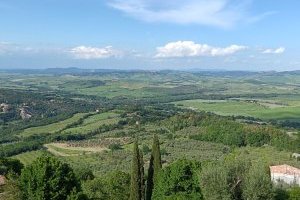
Val d'Orcia was one of the amazing experiences of traveling. We didn't have any exaggerated expectations, but the experiences were really worth it. We were accommodated in Rocca d'Orcia, a little below the tower and we had a wonderful view from the terrace, we didn't expect that Tuscany is so hilly (not just the towns on the hill). The evenings were wonderful, a glass of wine and the only thing we wished was that it wouldn't end. We went on trips around the area and the towns were also wonderful, just enough tourists. The natural thermal springs were not as warm as we expected, but the rocks were beautiful. What I don't recommend is the cypress circle, on private land, parking the car in a dangerous place and the circle itself is not much.
Keep reading 0 comments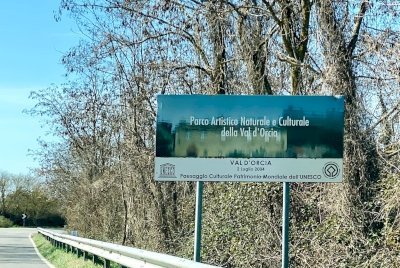
We visited the Val d’Orcia region as part of our 40th wedding anniversary Italy heritage hunting adventure. I consider this a WHS within a WHS as we planned to hit Val d’Orcia together with Pienza. Started our visit at Montepulciano and after considering various transport options (including renting an electric bicycle to walking) decided to take a cab instead. The journey of about 10km took us through the Val d’Orcia region and I caught the signage that is a ‘must stop’ for us heritage hunters. Hope this is helpful as the Val d’Orcia region is huge and will take time to walk and get to feel of this beautiful part of Tuscany! This inscription signage is roughly halfway between Montepulciano and Pienza! Look out for it! For the rest of our 25 WHS ……here’s a compilation for viewing pleasure…..(see link)
Keep reading 0 comments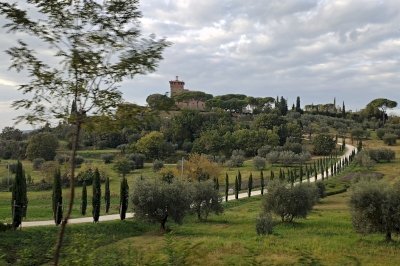
Can I tick off this site? A philosophical question I’m sure every World Heritage traveller has asked themselves at some point. For myself and Val d’Orcia, I would say technically yes although with some heavy asterisks. On a coach tour from Rome, we first stopped in Montepulciano, which is outside the core zone but offers a view of the idyllic Tuscan countryside. Well, it should but it was foggy when I visited so no luck there. From there we went to lunch, again outside the inscribed area, and finally to Pienza. The drive there certainly passed through Val d’Orcia and there were some good views from the coach (see picture attached) but I would always prefer to set foot in the site where possible. Finally, we had 30 minutes to explore Pienza at our own pace, which in my case was fast to see as much as possible. The fog had cleared so there were views of the countryside aplenty and just being in Pienza is a double tick. That being said, wandering around Pienza gives a good sense of why Pienza is inscribed but less so Val d’Orcia. Can I claim to have appreciated a site based on seeing it from afar, be it in a coach or from a hilltop vista? I don’t really think so and I would certainly like to return one day to visit San Quirico d’ Orcia, Montalcino, and the rest. The problem is there is just too much to see and do in …
Keep reading 0 comments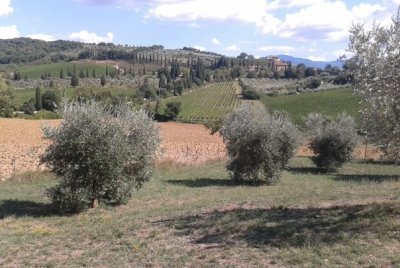
I visited this cultural landscape at least three-times during last ten years. As usually for cultural landscapes, it is quite difficult to recognize its OUV - actually, I need to read the ICOMOS evaluation report three-times to understand at least partly... The weirdest point is that the OUV of Val d`Orcia is expressed by another separate WHS - Pienza and by TWHS via Francigena. If I ingnore these political and rather artificial issues, I must say that I really enjoyed all my contacts with this site. Mostly, I simply crossed it by car or bus. I think that in this case it is OK, and one can recognize the qualities of the site even during the car tourism. The landscape is picturesque and different if compared with the neighbours such as Lazio. Hovewer, it has similar aspects as other landscapes in Tuscany and Umbria (La Crete between Siena and Asciano, Chianty etc.)
The sites that I explored by "getting out of the car" were Pienza (separate WHS with my review), Abbey of S Antimo with beautiful romanesque church and wonderful landscape around (PHOTO), and Bagni San Filippo (outdoor thermal baths!!!). I also enjoyed views towards Val d`Orcia from Montepulciano.
Even if it requires some effort to recognize and understand its qualities, it deserves the WHS status.
Keep reading 0 comments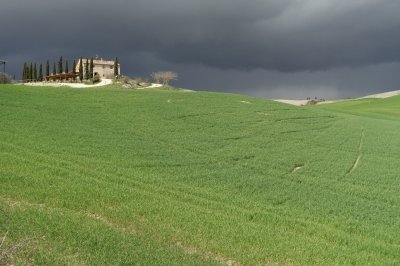
Coming in a few weeks later than Fredrik I faced neither snow nor cold. And at least in the morning when I departed from San Quirico the weather was great for a hike. I followed the historic Via Francigena from San Quirico to Bagno Vignoni with a stop at Vignoni and got great views of Ripa d'Orcia and Rocca d'Orcia. San Quirico itself is nice with it's cobble stone streets.
Only after I had left Bagno Vignoni and found myself stuck half way between Bagno Vignoni and Pienza with no village or shelter in between, did I notice the dark clouds forming to the North. They made for an excellent backdrop for my pictures. But after checking the wind direction, I knew what was coming my way. The plain Tuscan landscape may seem picturesque if the sun is shining. With heavy rains pouring down and me looking anxiously for any form of cover, some less barrenness would have helped. Lucky me, it wasn't that cold and my pants dried quickly when the clouds had passed.
The hike itself was really nice, disregarding the frequent times I had to walk on the road. I got to see both the rather mountaineous side of the Val d'Orcia as well as the more hilly parts around Pienza. The area offers plenty more hiking opportunities and I really feel that this is the best way to experience it.
The frequent complaint brought forward by community members is that site is redundant with Pienza already …
Keep reading 0 comments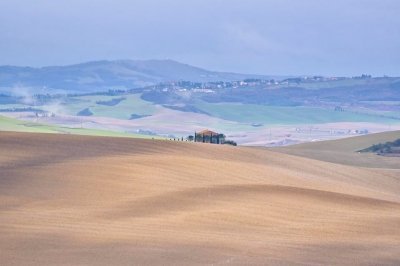
The effect from “Beast from the East” made my whole week of Italian trip on the Adriatic side of the Apennine to be miserably cold and wet, but when I crossed the Apennine to Tuscany, I was blessed with warmer temperature and some occasionally shower rain. Initially I was really happy that such kind of weather normally will create a wonderful mist in the morning, a perfect moment for photographers to make landscape photo for rolling hills of Val d’Orcia. However, when I reach Val d’Orcia area, heavy rain welcomed me, so heavy that I could not see anything except the road. I had no choice but to change my plan and directly went to Pienza. The rains continued until lunchtime and finally stopped at 2 PM, but even no rain, the sky was cloudy and rarely had sunshine, a worst element for photographing.
I drove out to San Quirico d’ Orcia from Pienza, along the way there were two famous spots for shooting photo. The first one was at the entrance road to Agriturismo Podorino B&B, the stunning view of Chapel Vitaleta on green hill from here was so lovely. Another spot was the behind the grove of trees near the bus stop before Ristorante La Taverna Del Barbarossa. From here was where the famous photo of Podere Belevede which become an iconic image of lonely mansion in Tuscany made. The view was great but because of cloudy sky I was really disappointed. After that I shortly drove …
Keep reading 0 comments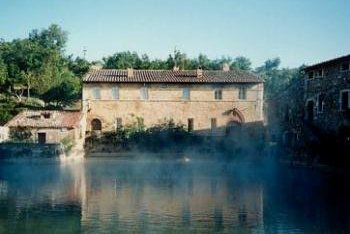
I've visited several villages in Val d'Orcia WHS as recently as last year, but my favorite is Bagno Vignoni, which I visited in 1997.
This village is known in Italy today for its high-end spa, but it was also the main setting for the Russian cinematic giant Andrei Tarkovsky's masterpiece Nostalgia (1983).
Nostalgia was directed by Tarkovsky but was written by him and Tonino Guerra, perhaps the world's finest screen writer of his generation and one of the top Italian poets, who took Tarkovsky around Italy for location hunting for the movie.
This photo of the main square of the village, which is filled with water from a nearby hot spring, was taken by me 20 years ago and has been converted to a digital photo.
It was prohibited to get in the water when I was there, but people had supposedly gathered in the water to chitchat for centuries, as you can see in Nostalgia, just like they have been doing so at any other squares in Europe.
The water at the square was consequently used as a metaphor for human condition to a devastating effect in the movie.
Apparently, Val d'Orcia inspires artists even today.
Keep reading 0 comments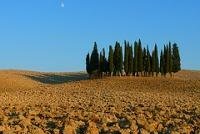
I visited this WHS in August 2013 and decided to take it easy to be able to enjoy the panoramic views, tiny villages, wineries and good food. I decided to base myself in San Quirico d'Orcia which is central to most interesting sites in the valley. I visited several places such as Castiglione d'Orcia, Rocca d'Orcia, Montalcino, Monticchiello, Montepulciano, La Foce, Chianciano Terme, Bagno Vignoni, Bagni San Filippo, etc. There is truly something for everyone here: food, wine, medievil cities, churches, art, thermal baths, hiking, photogenic landscapes, etc. I used to think that this WHS is rather redundant since Pienza is already inscribed on its own but I have come to think that it really deserves its status as a WHS and it really has an OUV if only you give it enough time to impress!
Keep reading 0 comments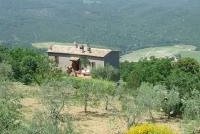
A large area of rural Tuscany, the Val d'Orcia boasts endless vinyards and olive groves spread over an undulating landscape.
A comfortable way of seeing this area is to take the Treno Natura from Siena on one of its periodic perigrinations - mostly on spring and autumn weekends. At other times the nearest station is at Buonconvento. From here I took buses to Montalcino and to Pienza. From both of these hilltop towns there are extensive views over the landscape.
Keep reading 0 comments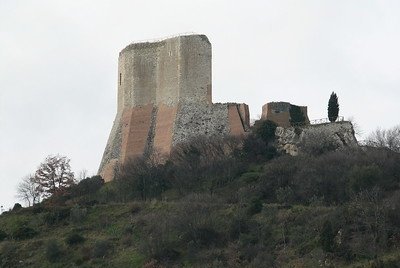
Although the landscape is pretty enough and quintessential Tuscan, this is a poor WHS. It has hills, olive trees and rows of cypresses. And there are still a lot of monumental farms around, although most of them seem to have been turned into Bed&Breakfasts.
My choice of sites to visit in this valley was limited because it was a Monday, the day that almost all sites in Italy that have paid access shut down. So no castles, monasteries, baths or mills for me. I just drove around a bit, taking some lesser roads, on my way to Orvieto (on the Tentative List, see separate review).
My first stop was at Castiglione d'Orcia. This town looks glued to the rocky hill where it's built at. There are some nice old stone houses, and narrow streets to lose your way in. Closeby is Rocca d'Orcia, one of the most characteristic fortresses that adorn the hills in the Val d'Orcia.
Along the way, there are also frequent signs pointing out the pilgrim's way Via Francigena. I think I encountered one pilgrim: an older man with walking sticks, braving the cold wind but well covered up in rain gear.
Keep reading 0 comments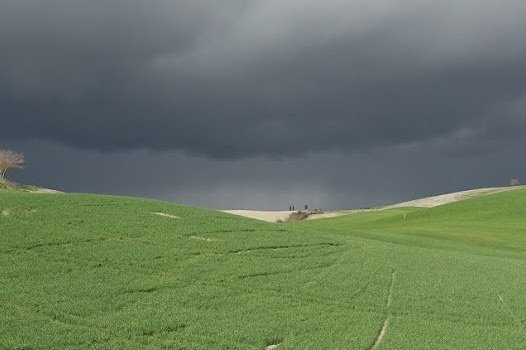
The Val d'Orcia is about two things for me: beautiful vistas and delicious wines. Staying with friends in a villa outside Siena in May 2004, I had ample opportunity to sample both. The roads in this part of Tuscany provide the archetypal imagery that has made the province famous, and the wines of Montalcino and Montepulciano are experiences in themselves.
Keep reading 0 comments
